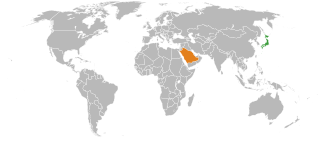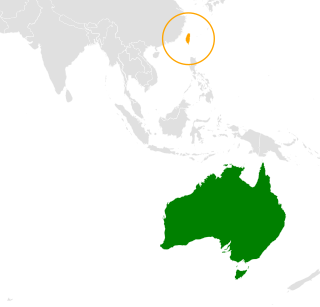The Five Principles of Peaceful Coexistence are the Chinese government's foreign relations principles first mentioned in the 1954 Sino-Indian Agreement. Also known as Panchsheel, these principles were subsequently adopted in a number of resolutions and statements, including the preamble to the Constitution of the People's Republic of China.

The Treaty of San Francisco, also called the Treaty of Peace with Japan, re-established peaceful relations between Japan and the Allied Powers on behalf of the United Nations by ending the legal state of war and providing for redress for hostile actions up to and including World War II. It was signed by 49 nations on 8 September 1951, in San Francisco, California, at the War Memorial Opera House. Italy and China were not invited, the latter due to disagreements on whether the Republic of China or the People's Republic of China represented the Chinese people. Korea was also not invited due to a similar disagreement on whether South Korea or North Korea represented the Korean people.

The Joint Communiqué of the United States of America and the People's Republic of China, also known as the Shanghai Communiqué (1972), was a diplomatic document issued by the United States of America and the People's Republic of China on February 27, 1972, on the last evening of President Richard Nixon's visit to China.

The Joint Communique of the Government of Japan and the Government of the People's Republic of China was signed on September 29, 1972, in Beijing. The communique established and normalized diplomatic relations between Japan and the People's Republic of China (PRC), resulted in the severing of official relations between Japan and the Republic of China (ROC) in Taiwan. The document produced nine articles in a joint statement, showing compromises on previously ambiguous principles enunciated by both sides. Of these, four points are particularly worthy of attention:
- the desire for a peace treaty between Japan and China;
- the statement that Japan "understands and respects [China's] stance" that Taiwan is part of the PRC;
- an Asia-Pacific anti-hegemony clause;
- Japan's reversal of relations with China and Taiwan.

In the People's Republic of China, Deng Xiaoping formally retired after the 1989 Tiananmen Square protests and massacre, to be succeeded by former Shanghai CCP secretary Jiang Zemin. During that period, also known as Jiangist China, the crackdown of the protests in 1989 led to great woes in China's reputation globally, and sanctions resulted. The situation, however, would eventually stabilize. Deng's idea of checks and balances in the political system also saw its demise with Jiang consolidating power in the party, state and military. The 1990s saw healthy economic development, but the closing of state-owned enterprises and increasing levels of corruption and unemployment, along with environmental challenges continued to plague China, as the country saw the rise to consumerism, crime, and new-age spiritual-religious movements such as Falun Gong. The 1990s also saw the peaceful handover of Hong Kong and Macau to Chinese control under the formula of One Country, Two Systems. China also saw a new surge of nationalism when facing crises abroad.
The New Japan–Republic of Korea Partnership towards the Twenty-first Century was a declaration made on October 8, 1998, between Japanese Prime Minister Keizō Obuchi and South Korean President Kim Dae-jung to reconfirm friendly relations between Japan and South Korea, as well as declare that both countries will discuss the future of Japan-South Korea relations in order to build a new Japan–South Korea partnership. This declaration is also called the Japan–South Korea Joint Declaration of 1998.

The Sino-Japanese Peace Treaty, formally the Treaty of Peace between the Republic of China and Japan and commonly known as the Treaty of Taipei, was a peace treaty between Japan and the Republic of China (ROC) signed in Taipei, Taiwan on 28 April 1952, and took effect on August 5 the same year, marking the formal end of the Second Sino-Japanese War (1937–1945).
The anti-Japanese demonstrations of 2005 were a series of demonstrations, some peaceful, some violent, which were held across most of East Asia in the spring of 2005. They were sparked off by a number of issues, including the approval of a Japanese history textbook and the proposal that Japan be granted a permanent seat on the United Nations Security Council.

The Murayama Statement was a political statement released by former Prime Minister of Japan Tomiichi Murayama on August 15, 1995, officially titled "On the Occasion of the 50th Anniversary of the War's End".

Relations between the Russian Federation and Japan are the continuation of the relationship of Japan with the Soviet Union from 1917 to 1991, and with the Russian Empire from 1855 to 1917. Historically, the two countries had cordial relations until a clash of territorial ambitions in the Manchuria region of northeastern China led to the Russo–Japanese War in 1904, ending in a Japanese victory which contributed to the weakening of the monarchy in Russia. Japan would later intervene in the Russian Civil War from 1918 until 1922, sending troops to the Russian Far East and Siberia. That was followed by border conflicts between the new Soviet Union and the Empire of Japan throughout the 1930s. The two countries signed a nonaggression pact in 1941, although the Soviet government declared war on Japan anyway in August 1945, invading the Japanese puppet state of Manchukuo as well as seizing the Kuril chain of islands just north of Japan. The two countries ended their formal state of war with the Soviet–Japanese Joint Declaration of 1956, but as of 2022 have not resolved this territorial dispute over ownership of the Kurils. Due to the 2022 Russian invasion of Ukraine, relations became very tense after Japan imposed sanctions against Russia. Russia placed Japan on a list of "unfriendly countries", along with Taiwan, South Korea, Singapore, the United States, European Union members, NATO members, Canada, Australia, New Zealand, Norway, Switzerland, Micronesia and Ukraine.

The complex relationship between Japan and Taiwan dates back to 1592 during the Sengoku period of Japan when the Japanese ruler Toyotomi Hideyoshi sent an envoy named Harada Magoshichirou to the Takasago Koku 高砂国 (Taiwan). The bilateral trading relations continued through the Dutch colonial rule and the Tungning Kingdom of Taiwan in 17th century before the completion of Japan's Sakoku policy. After the Meiji restoration in latter half of the 19th century, Japan resumed its expansionist ambition upon Taiwan and successfully annexed Taiwan under Japanese rule from 1895 to 1945, until the surrender of Japan after World War II. Taiwan was also surrendered by Japan to the Republic of China in 25th October 1945.

Anti-Japanese sentiment in China is an issue with modern roots (post-1868). Modern anti-Japanese sentiment in China is often rooted in nationalist or historical conflict, for example the atrocities and war crimes committed by the Japanese in the First Sino-Japanese War, Boxer Rebellion, Siege of Tsingtao, Second Sino-Japanese War and Japan's history textbook controversies.

China–Japan relations or Sino-Japanese relations are the bilateral relations between China and Japan. The countries are geographically separated by the East China Sea. Japan has been strongly influenced throughout its history by China, especially by the East and Southeast through the gradual process of Sinicization with its language, architecture, culture, cuisine, religion, philosophy, and law. When Japan was forced to open trade relations with the West after the Perry Expedition in the mid-19th century, Japan plunged itself through an active process of Westernization during the Meiji Restoration in 1868 and began viewing China under the Qing dynasty as an antiquated civilization unable to defend itself against foreign forces—in part due to the First and Second Opium Wars along with the Eight-Nation Alliance's involvement in suppressing the Boxer Rebellion. Japan eventually took advantage of such weaknesses by invading China, including the First Sino-Japanese War and the Second Sino-Japanese War.

Canada and Japan have an amicable companionship in many areas. Diplomatic relations between both countries officially began in 1928 with the opening of the Japanese consulate in Ottawa. In 1929, Canada opened its Tokyo legation, the first in Asia; and in that same year, Japan its Ottawa consulate to legation form.

The China–Japan–South Korea trilateral summit is an annual summit meeting held between the People's Republic of China, Japan and South Korea, three major countries in East Asia and the world's second, third and 12th largest economies. The first summit was held during December 2008 in Fukuoka, Japan. The talks are focused on maintaining strong trilateral relations, the regional economy and disaster relief.

Japan–Saudi Arabia relations are the foreign relations between Saudi Arabia and Japan. Official relations between the two nations were established in 1955.

Relations between the Commonwealth of Australia and the Republic of China, formerly the Qing dynasty, date back to 1909. Since 1972, the political status and legal status of Taiwan have been contentious issues. Australia and Taiwan share partnership in the inter-governmental Global Cooperation and Training Framework (GCTF) activities.

The 49th G7 summit was held from 19 to 21 May 2023 in Hiroshima city of Hiroshima Prefecture.
The Japan–China Trade Agreement of 1974 served as a continuation of various treaties between the People's Republic of China (PRC) and Japan during the Cold War. The treaty was an important step in the normalization of relations between China and Japan, after diplomatic and economic ties had been formally re-established via the 1972 Japan–China Joint Communiqué. The talks were headed by China's Minister of External Trade and eventual Premier, Zhou Enlai (1898–1976), and Japan's Prime Minister, Tanaka Kakuei (1918–1993). The treaty was successful due to China's road to internationalism after 1972, followed by a series of diplomatic treaties, such as the Japan-China Aviation Pact, the Maritime Agreement, the Fisheries Agreement, and the Trade Mark Protection Agreement, concluding with the official Japan-China Peace and Friendship Treaty of August 1978.
















